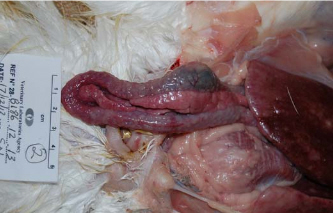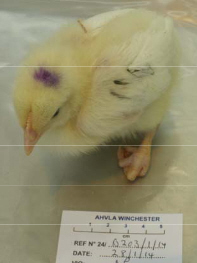



GB Emerging Threats Report: Avian Diseases: January-March (Q1) 2014
Among the highlights included in this quarterly report are ongoing issues with reovirus-associated tenosynovitis in broilers and Marek’s disease in turkeys. Marek’s disease virus genome has also been detected in a goose. Vitamin B2 deficiency was the likely cause of curled-toe paralysis in young organic chicks.Highlights
Submission trends: Increase of 15 per cent in the total number of avian diagnostic submissions to AHVLA and SAC during Q1-2014 compared with Q1-2013. This includes a rise of 11 per cent in the total number of avian diagnostic submissions received by AHVLA and a rise of 93 per cent received by SAC.
New & Re-emerging diseases: Ongoing diagnoses of reovirus-associated tenosynovitis in broilers and Marek’s disease in turkeys.
Unusual diagnoses: Marek’s disease virus genome detected in a lymphoma in a goose; curled-toe paralysis in chicks.
Changes in the industry and disease patterns: Slight decline in chick placings in the broiler sector compared with the peak of 2012-2013; increase in layer chick placings and an improvement in wholesale egg prices leading up to Easter.
New and Re-emerging Diseases and Threats
Maintaining good biosecurity and hygiene standards, disease awareness and vigilance and prompt investigation of problems are essential to limit both the risk of introduction and spread of infection and the impact of disease outbreaks. Surveillance activities and PVS and industry contact continue to monitor for the presence of any potential new or re-emergent threats in the GB poultry population.
Ongoing New and Re-emerging Disease Investigations
Reovirus-associated tenosynovitis/arthritis in broilers
Investigations of lameness and tenosynovitis problems in broilers have continued during Q1-2014. A further reovirus-related tenosynovitis and pericarditis diagnosis has been achieved in sequential flocks from the same farm over this quarter. A reovirus was isolated in tissue cultures from the affected tendon and heart tissues. It is not known whether the parent flocks used by this enterprise are routinely vaccinated for the virus. Reovirus is a 'normal' inhabitant of the intestinal tract and while the majority of strains are considered non-pathogenic, infections with pathogenic reovirus in broilers appear to be on the increase, and the identification of new types has been reported (Troxler and others, 2013).
The pathogenic strains are mainly associated with poor, uneven growth and lameness with splay-legs and partial to complete tendon ruptures. An age-related resistance develops from two weeks of age but susceptibility prior to that depends on the level of protective maternal antibodies and the virulence of field strains. The efficacy of vaccinal protection conferred by existing vaccines is variable.
The disease may cause welfare problems and also a variable economic impact. Although reoviruses are not associated with public health or international trade implications, veterinary investigation of affected flocks is important to monitor the impact on animal welfare and to implement appropriate prevention and control measures (Anon, 2013). The situation will continue to be monitored through AHVLA scanning surveillance activities.
Marek’s disease in turkeys
Marek’s disease was identified as the cause of visceral lymphomas in turkeys. There were approximately 25 deaths within a flock of 195, five-month-old turkeys when the investigation commenced in December 2013.
Four birds underwent post-mortem examination and all were found to have visceral enlargement and diffuse, cream-white, solid lesions involving the spleen, liver and kidneys and, in one case, nodular lesions in the duodenum and pancreas (Figure 1).

A neoplastic condition was suspected and this was supported by the demonstration of lymphomatous changes consistent with Marek’s disease on histopathology, including in the duodenum and pancreas. Real-time PCR assays of spleen confirmed a high level of virulent Marek’s disease virus (MDV-1). Marek’s disease is principally a disease of chickens but is increasingly being identified in turkey flocks (Blake-Dyke & Baigent, 2013), often following a background of direct or indirect contact with chickens.
Unusual Diagnoses
Endemic poultry diseases, including some unusual cases, continued to be diagnosed in backyard and commercial poultry during Q1-2014 in GB, with some interesting and unusual investigations outlined below. A selection has also been described in the monthly surveillance highlight reports published in the Veterinary Record (AHVLA, 2014a, b; SAC, 2014). In these cases no wider threats were recognised and no specific actions required other than for producers and veterinarians to maintain vigilance for disease problems and investigate as appropriate.
Detection of virulent Marek’s disease genome in a lymphoma in a goose
Two adult geese on one premises died six weeks apart after having become lethargic and developing a swollen abdomen, collapse and eventual death. A few weeks later, a third bird died after showing similar signs and was submitted for post-mortem examination. Six ducks and some chickens on the premises appeared unaffected.
Grossly, the liver was enlarged, pale with irregular pale fatty-looking firm areas. The spleen was also enlarged. Histopathology confirmed a disseminated lymphocytic neoplasm, resembling Marek’s disease.
A low level of virulent Marek’s disease virus MDV-1 was confirmed by PCR testing. Marek’s disease is principally a disease of chickens, although virulent strains of MDV have been previously been detected in wild, migratory white fronted geese (Anser albifrons) in Japan and Far Eastern Russia without evidence of overt clinical disease, implying that these geese may be resistant to the effects of MDV (Murata and others, 2007). Further investigation is being undertaken on the MDV-1 detected in this goose, and the possible role of this virus in lymphomatous neoplasia in geese and ducks should be investigated further by scanning surveillance.
Curled-toe paralysis in chicks

showing signs of curled-toe
paralysis associated with
riboflavin deficiency
Three, three-week-old chicks were submitted for post-mortem examination from a group of 65 chicks delivered as day-olds, comprising a mixture of breeds. The history indicated curling of the toes under the birds and walking on curled feet, which was confirmed on clinical assessment of the submitted birds which showed marked medial curling of the toes of one or both feet (Figure 2). Post-mortem examination showed possible thickening of the sciatic nerve in the birds but no other abnormalities were noted.
The findings and presentation of the birds was suggestive of curled-toe paralysis due to riboflavin (vitamin B2) deficiency in the diet. Histopathological examination of the sciatic nerves revealed changes consistent with riboflavin deficiency. The birds were being fed an organic diet which had no synthetic vitamin supplementation.
Curled-toe paralysis is an uncommon clinical manifestation of dietary riboflavin deficiency but can occur when cereal-based diets, which can be low in natural riboflavin content, are not supplemented with the vitamin. Unless the nerve damage has been irreversible, there is usually a good response to riboflavin or vitamin B complex supplementation, as reported in this case following B-vitamin supplementation via the water.
Further Reading
You can view the full report by clicking here.
Find out more about the diseases mentioned by clicking here.
July 2014











